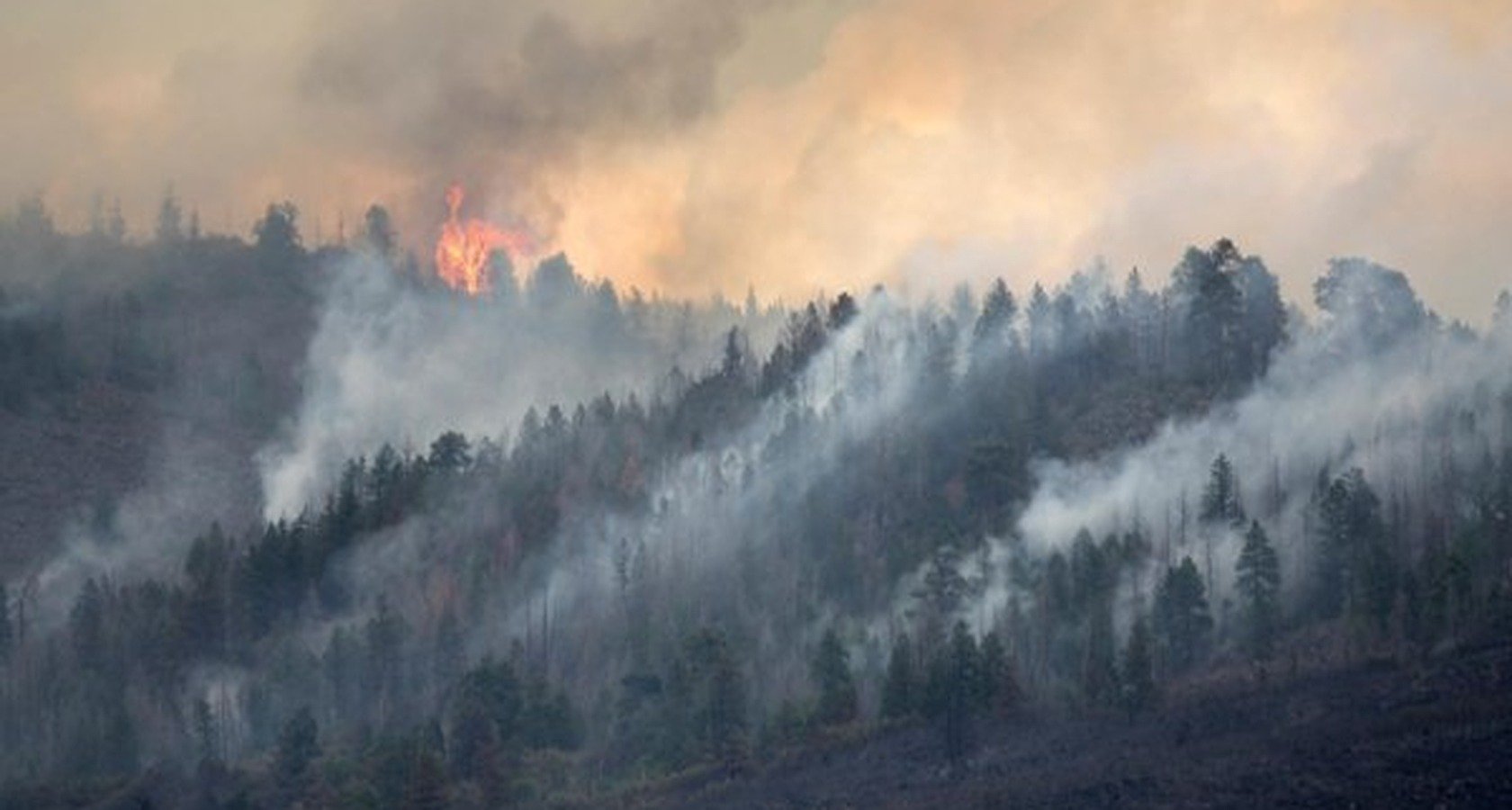Harmful Health Effects of Toxic Air Pollutants from Wildfire Smoke Exposure
Quarantine has taken on a whole new meaning for many people in the Western states as they have been forced to take shelter from the coronavirus pandemic and now from dense wildfire smoke filling the skies. Dozens of wildfires have burned their way through the west coast over the last month, forcing thousands to stay inside and tens of thousands to leave their homes. Lightning strikes in August sparked a large number of fires, but warm temperatures and exceptionally dry conditions fueled even more blazes.
The National Interagency Fire Center (NIFC) reports that as of mid-September 2020, 78 large fires have burned 3.9 million acres nationally, with nearly 32,000 firefighters and support personnel assigned to fires across the west.1 Scientists have revealed this to be the region’s worst wildfire season in 18 years and have linked their increasing prevalence and intensity to climate change. The wildfire smoke has been so hazardous that Air Quality Indexes in some areas of Oregon, California and Washington showed smoke levels and air pollution beyond the measurable scale.2
Plumes of smoke from the fires grew so large that hazardous particulate matter not only spread across the western United States, but have crossed the Atlantic Ocean and reached the skies of Europe.3 Even if you aren’t on evacuation notice, the fires have emitted so much pollution that exposure to the smoky air is now a global health concern.
While little is still known about the health impacts of long-term exposure to wildfire smoke, the inhalation of air pollution is incredibly dangerous to public health.
The EPA has noted that the biggest health threat from wildfire smoke is from particulate matter (PM), especially PM10 and PM2.5. PM2.5 is one of the most common air pollutants. It is a relatively small particle, but has a large surface area and has been found to have a greater impact on human health when compared to some of its larger counterparts. Its size and unique structure allow it to be carried through airways, bypassing the body's filtration systems and reaching deep into the respiratory system. This penetration allows PM2.5 to have significant toxic effects, limiting lung function and causing damage to the body’s internal systems. Exposure to these fine particles can be even more dangerous for vulnerable populations like older adults, young children and pregnant women, those with pre-existing respiratory conditions like COPD, pre-existing heart disease, and those who have been exposed to COVID-19. Short-term exposure has been known to cause acute symptoms to the respiratory system such as shortness of breath, coughing and wheezing, and runny nose. Long-term inhalation of particulate matter has been linked to chronic cardiovascular disease, lung disease, immune system activation, and decreased average lifespan.4
If you are in an area affected by wildfire smoke and poor air quality, here are some basic tips to keep yourself safe and healthy:
- Minimize exposure to air pollution by staying indoors as much as possible.
- Protect your indoor air quality by keeping windows and doors closed.
- Avoid vacuuming, burning candles, or using aerosol sprays as these are sources of indoor pollution.
- It is OK to vacuum if you have a vacuum with a HEPA filter. This may help to reduce some of the indoor pollution.
- If your home has air conditioning or a high-efficiency particulate air filter, use it. If it does not, consider purchasing an air purifier or HEPA filters for your air conditioner.
- Diffuse essential oils like lavender, lemon and eucalyptus in your home. These act as natural air cleaners.
- Avoid outdoor exercise and limit exertion indoors.
- If you have to go outside, the best solution is to wear a P100 or an N95 respirator mask with an exhalation valve if available to you. These will help filter fine particles and particulate matter found in wildfire smoke.
- If you do go out, avoid bringing air pollution inside by changing clothes and showering when you return.
- If you use a rescue inhaler medicine such as albuterol, keep a spare on hand.
- Pay close attention to symptoms and seek medical help from your health care provider at the first sign of trouble.
Want to do more to optimize your health during this critical time? The upside is that you can use nutrition, sleep, hydration and stress reduction to strengthen your immune system, support your lungs and mucus membranes, and fight the harmful health impacts of wildfire smoke exposure.
Nutrition
Nutrition is a pillar of every day health, and eating a diet focused on phytonutrient-rich foods when exposed to harmful substances, can help lighten your toxic load. Simply put, phytonutrients are what give foods their bright colors and distinct taste. They are natural compounds in plant foods that act as powerful defenders of health. These colorful compounds help the body to remove toxins, boost the immune system, fight cardiovascular disease, promote healthy hormone production and metabolism, and help to prevent cancer.
Glutathione is one of the most important phytonutrients humans need in order to stay healthy. Our bodies can produce our own glutathione, but toxins, like the ones seen in wildfire smoke, can deplete our supply. Without enough glutathione the liver can get overwhelmed, damaged and unable to detox properly, making cells more susceptible to harm from oxidative stress, free radicals, infections and cancer.
Glutathione is made up of sulfur chemical groups called sulforaphane. These groups act as sticky surfaces that catch and trap all harmful things in the body. If there aren’t enough of these antioxidants, the toxic load can become too great for the body.5 Fruits and vegetables are the best sources of phytonutrients, but cruciferous vegetables like broccoli and broccoli sprouts, cabbage and Brussels sprouts, as well as onions and garlic are going to be essential for increasing sulforaphane and glutathione levels.
When adapting to phytonutrient focused eating patterns, increase real, plant foods and decrease ultra-processed, packaged goods. Aiming for one to two of each color per day is a simple first step in increasing your intake. For best practice, try to eat as much as eight or more cups of colorful vegetables daily. All phytonutrients are vital for better health, and it is recommended to increase variety and intake of these foods during wildfire season to protect cells, boost the immune system, and fight systemic inflammation.
Hydration
Staying hydrated is critical to human survival, but becomes even more important when our bodies are under environmental stress. Not only does water keep the mucus membranes of our respiratory system moist and functioning, but it helps flush unwanted air pollutants from the body. Our liver and kidneys play a vital role in removing toxins from the body and they need a sufficient amount of water to properly filter and eliminate. Another vital pathway for detoxification is through digestive elimination. Dehydration is one of the leading causes of constipation, which keeps toxins in circulation within the body. Staying hydrated optimizes digestion by keeping things moving regularly, pushing food through the digestive tract and promoting the elimination of harmful compounds.
To stay hydrated, try to consume half of your weight in ounces of water per day, more if you’re exercising or have had moderate smoke exposure. Eating more water-heavy foods is another way to ensure you’re getting enough fluids. Here are some to try:
- Cucumber
- Lettuces
- Zucchini
- Watermelon
- Broths and soups
- Celery
- Tomatoes
- Cauliflower
- Bell pepper
Particles from smoke can also contaminate water supplies. If you are in an area with heavy smoke exposure, it is recommended you use a water filtration system like Berkey.
Sleep
You know sleep is a powerful tool, but did you know that sleep can help fight systemic inflammation? While optimal sleep may be hard to obtain during stressful times, try your best to maintain routine sleep cycles and restful sleep periods. Adequate sleep will help support your body as it endures a more stressful and toxic environment. A lack of sleep can increase the hormone cortisol to unhealthy levels and promote inflammation. This hormone imbalance can disrupt our circadian rhythms which regulate our immune system and with it, our levels of inflammation. With a suppressed immune system, we are less likely to fight off harmful air pollutants from smoke exposure, and are more prone to unhealthy levels of inflammation, therefore more at risk for diseases like metabolic syndrome, cancer and heart disease.
For a more restful night of sleep, aim for 7-9 hours per night, go to sleep and wake and the same time each day, keep your room cool, quiet and free of electronics, and stop using electronics 30-60 minutes prior to sleep. If you are still struggling to sleep, apps like Calm, Breathwrk and Buddhify offer bedtime exercises that may help ease the mind and allow you to fall asleep easier.
Stress
Wildfire season is naturally a stressful time, and wildfire smoke exposure worsens our environmental health. This release of toxins causes even more physical stress on our bodies. Reducing and transforming stress is another important tool to help combat the effects of smoke inhalation. When our bodies are under mental, physical and emotional stress, we can experience low heart rate variability (HRV).
HRV is a measurement in the variation time between each heartbeat. The variations are controlled by our autonomic nervous system and works to regulate heart rate, blood pressure, digestion and breathing. It also helps to control the fight-or-flight mechanism and the relaxation response. Stressors can launch our bodies into a fight-or-flight overdrive and cause nervous system imbalances. This shift will reduce HRV, increasing risk for worsening mental health, cardiovascular disease and death. Those with higher HRV have greater cardiovascular strength, decreased anxiety and depression, and are more resilient to stress.6
The key to stress reduction is finding a practice that you enjoy and will continue to do regularly. Meditation, journaling, yoga, deep breathing, and prayer are just some of the effective modalities that will elicit a relaxation response, improve HRV and reduce stress. In addition, HeartMath biofeedback is a great system for monitoring and improving your HRV.
While you may not be able to escape the smoke this fire season, these precautions and extra steps will help support your body fight off the environmental stressors around you and move you toward a more vital level of health. If you believe the smoke exposure has caused you health problems like worsening lung function, difficulty breathing or other urgent health effects, please contact your healthcare provider.
Want more information on wildfires and how to protect yourself from the dangers of smoke exposure? Check out our Smoke Exposure Support Program. In this program we present a comprehensive tool kit that provides concrete nutrition, lifestyle, and recommendations for supplement protocols to help you and your family cope with this new challenge that we are experiencing annually.
References:
- NIFC (2020). Fire Information. National Interagency Fire Center. Retrieved from https://www.nifc.gov/index.html. Accessed 21 September 2020.
- AirNow (2020). Air Quality Index. AirNow. Retrieved from https://www.airnow.gov/aqi/. Accessed 21 September 2020.
- NASA (2020). Historic Fires Devastate the U.S. Pacific Coast. Earth Observatory. Retrieved from https://earthobservatory.nasa.gov/images/147277/historic-fires-devastate-the-us-pacific-coast. Accessed 21 September 2020.
- Xing, Y., Xu, Y., Shi, M., & Lian, Y.. (2016). The impact of PM2.5 on the human respiratory system. Journal of Thoracic Disease. Retrieved from https://www.ncbi.nlm.nih.gov/pmc/articles/PMC4740125/. Accessed 21 September 2020.
- Egner, P., Chen, J.G., Zarth, A., Ng, D., Want, J.B., et al. (2014). Rapid and Sustainable Detoxication of Airborne Pollutants by Broccoli Sprout Beverage: Results of a Randomized Clinical Trial in China. American Association for Cancer Research. Retrieved from https://www.ncbi.nlm.nih.gov/pmc/articles/PMC4125483/. Accessed 21 September 2020.
- Campos, M. (2017). Heart Rate Variability: A new way to track well-being. Harvard Health Publishing, Harvard Medical School. Retrieved from https://www.health.harvard.edu/blog/heart-rate-variability-new-way-track-well-2017112212789. Accessed 21 September 2020.





